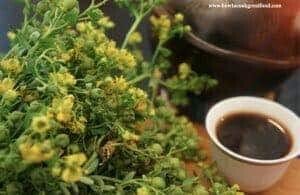 Tena’Adam (ጤና አዳም) also known as Rue in english, is a plant herb historically associated with magic mysticism and witchcraft. Since ancient times its been used in a variety of ways.
Tena’Adam (ጤና አዳም) also known as Rue in english, is a plant herb historically associated with magic mysticism and witchcraft. Since ancient times its been used in a variety of ways.Tena’adam is used for food preparation (flavoring agent) as well as for it medicinal properties. Its name in Amharic, which directly translates to “health of Adam” signifies its medicinal faculties.
Ethiopians use the fresh plant for its pungency: because of its pleasant aroma and flavor its used to flavor sour milk, cheese, in hot beverages like coffee and kuti. The berry is used in spice blends such as berbere, shiro…
The fresh leaves are added to boiling water or milk and given to children to remedy upset stomachs and poor bowl movements. In “Ethiopian folk medicine, it is also used to treat colicky babies, earache, heart pain, hemorrhoids, influenza and intestinal disorder”.
In North Africa an infusion of tena’adam is used for colds, earache and intestinal problems. Due to its potent smell, it’s used as a scorpion repellant. In Algeria, the infused plant is used as nose drops to treat vomiting and fevers in children.
The oil extract is used as an antidote, used to counter poisonous snakebites. The herb is also known as anti-arthritic, anti-rheumatic, anti-epileptic, anti-hysteria, and has antiviral, anti-inflammatory, anti-fungal, anti-bacteria properties. In small amounts, it is noted to alleviate headaches.
Women in various parts of Ethiopia place the herb behind their ear for its scent (as perfume), as a form of protection and to alleviate headaches.
Note: the medicinal components of Tena’Adam have not been scientifically studied or confirmed.














